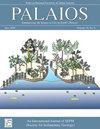TAPHONOMIC CONTROLS ON MICROBIALITE TEXTURES FROM THE STEAMBOAT POINT MEMBER, UPPER ORDOVICIAN BIGHORN DOLOMITE, WESTERN TETON MOUNTAINS, USA
IF 1.5
4区 地球科学
Q2 GEOLOGY
引用次数: 0
Abstract
Abstract: The Bighorn Dolomite is a massive, cliff-forming dolostone unit found across the state of Wyoming and adjacent areas that records the transition from greenhouse to icehouse conditions during the Late Ordovician. The basal Steamboat Point Member of the Bighorn Dolomite contains cm-scale mottled fabrics often attributed to the ichnogenus Thalassinoides, but their origin remains enigmatic in Upper Ordovician strata. The development of mottled fabrics may have significant implications for marine chemistry and paleoecology. We analyzed cm-scale mottled fabrics from the basal Steamboat Point Member of the western Teton Mountains to determine their origin and develop criteria for identification of similar mottled fabrics found in other Upper Ordovician strata. In vertical cross-section, massive, m-scale exposures display vertical columns (approximately 1 cm in diameter) that anastomose and maintain decimeter-scale vertical continuity. Microscopically, the columns are composed of micro-peloidal micritic textures surrounded by spar and microspar, whereas the intercolumnar matrix is composed of dolomicrite grains, skeletal clasts, and intraclasts. We interpret the microscopic peloidal texture as a product of benthic microbial calcification that coalesced to form mesoclots—diagnostic features of thrombolitic microbialites. Paragenetic analyses reveal evidence for early lithified microbial biofilms despite dolomite replacement and aggrading neomorphism. These observations indicate the Steamboat Point Member of the Bighorn Dolomite was deposited in seawater that was highly supersaturated with respect to carbonate, consistent with other studies that suggest deposition during greenhouse conditions prior to the end-Ordovician glaciation. We present a novel ternary diagram that contains criteria to help differentiate between burrows, microbialite textures, or physical processes that may result in mottled fabrics in the rock record.美国西提顿山上奥陶统大角白云岩汽船点段微生物岩结构的地理控制
摘要:大角白云岩是一个巨大的、形成悬崖的白云岩单元,分布在怀俄明州和邻近地区,记录了晚奥陶世从温室到冰库条件的转变。大角白云岩的Steamboat角基底段含有厘米级的斑点织物,通常被认为是海生海生石藻属的,但它们的起源在上奥陶统地层中仍然是谜一样的。斑点组构的发展可能对海洋化学和古生态学具有重要意义。我们分析了提顿山脉西部Steamboat Point基底段的厘米级斑点组构,以确定它们的起源,并制定了识别其他上奥陶统地层中发现的类似斑点组构的标准。在垂直剖面中,大规模m级暴露显示垂直柱(直径约1厘米),这些柱吻合并保持分米级的垂直连续性。微观上,柱状体由微球粒微晶结构组成,周围为晶石和微长石,而柱间基质由白云石颗粒、骨架碎屑和碎屑内碎屑组成。我们将显微镜下的球粒结构解释为海底微生物钙化的产物,这些钙化结合形成中凝块——血栓性微生物的诊断特征。共生分析揭示了早期岩化微生物生物膜的证据,尽管白云石置换和加积新生作用。这些观测结果表明,大角白云岩的Steamboat Point段沉积在碳酸盐高度过饱和的海水中,这与其他研究一致,这些研究表明,在奥陶纪末冰川作用之前的温室条件下沉积。我们提出了一种新的三元图,该图包含有助于区分洞穴、微生物岩纹理或可能导致岩石记录中斑点织物的物理过程的标准。
本文章由计算机程序翻译,如有差异,请以英文原文为准。
求助全文
约1分钟内获得全文
求助全文
来源期刊

Palaios
地学-地质学
CiteScore
2.80
自引率
12.50%
发文量
40
审稿时长
6 months
期刊介绍:
PALAIOS is a monthly journal, founded in 1986, dedicated to emphasizing the impact of life on Earth''s history as recorded in the paleontological and sedimentological records. PALAIOS disseminates information to an international spectrum of geologists and biologists interested in a broad range of topics, including, but not limited to, biogeochemistry, ichnology, paleoclimatology, paleoecology, paleoceanography, sedimentology, stratigraphy, geomicrobiology, paleobiogeochemistry, and astrobiology.
PALAIOS publishes original papers that emphasize using paleontology to answer important geological and biological questions that further our understanding of Earth history. Accordingly, manuscripts whose subject matter and conclusions have broader geologic implications are much more likely to be selected for publication. Given that the purpose of PALAIOS is to generate enthusiasm for paleontology among a broad spectrum of readers, the editors request the following: titles that generate immediate interest; abstracts that emphasize important conclusions; illustrations of professional caliber used in place of words; and lively, yet scholarly, text.
 求助内容:
求助内容: 应助结果提醒方式:
应助结果提醒方式:


